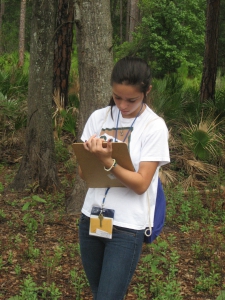Who Is This Module For?

The module is designed for 9-12th grade educators but can be adapted for 6-8th grade students and college classes as well.
Both standard and advanced placement secondary classes will find these activities useful. Each activity includes a section on how to adapt it to grades 6–8 or basic high school classes. Teachers of introductory biology and environmental science classes in colleges may find these activities helpful to bring concepts to life in their region.
Many existing climate education resources focus on the physics of climate change for earth science classes.So these do not.
We provide a brief introduction to climate science (Activity 2: Clearing the Air) to serve as a foundation for the rest the activities. All other activities focus on the impacts of climate change on forest ecosystems, adapting to projected changes, and the role of forests in reducing atmospheric carbon dioxide.
This module was created for biology, agriculture, and environmental science teachers but government, economics, math, and language arts classes may enjoy using some of these activities too.
Because complex societal problems weave together science, policy, and human behavior, these activities blur the boundaries between biology, environmental science, social studies, and civics courses. This subject correlations chart may help educators choose appropriate activities for their courses.
These activities support STEM education by linking closely with principles that underpin science and technology.
Students learn to apply science to current challenges and explore potential solutions to mitigate or adapt to climate change. The activities explore real world STEM topics including the carbon cycle, genetic breeding trials, computer models and databases, engineering and life cycle assessments of products. The activities are correlated to the Next Generation Science Standards. And, in support of Common Core standards, these activities also enable students to practice critical thinking and writing skills.
Watch a short presentation describing how these activities can be used to meet learning standards.
Research connections help make science current and introduce careers.
Teachers find that the many links between these activities and current research projects help engage students in thinking about science as a process and a potential career. Videos with graduate students and additional information on pinemap.org can supplement these activities.
